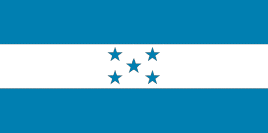
Honduras
|
Honduras History |
Click on map to see it in detail |
| Honduras History |
During the first millennium, Honduras was inhabited by the Maya. Columbus explored the country in 1502. Honduras, with four other Central American nations, declared its independence from Spain in 1821 to form a federation of Central American states. In 1838, Honduras left the federation and became independent. Political unrest rocked Honduras in the early 1900s, resulting in an occupation by U.S. Marines. Dictator Gen. Tiburcio Carias Andino established a strong government in 1932. In 1969, El Salvador invaded Honduras after Honduran landowners deported several thousand Salvadorans. Five thousand people ultimately died in what is called "the football war," because it broke out during a soccer game between the two countries. By threatening economic sanctions and military intervention, the Organization of American States (OAS) induced El Salvador to withdraw. After a decade of military rule, parliamentary democracy returned with the election of Roberto Suazo Córdova as president in 1982. However, Honduras faced severe economic problems and tensions along its border with Nicaragua. "Contra" rebels, waging a guerrilla war against the Sandinista regime in Nicaragua, used Honduras as a training and staging area. The U.S. also used Honduras for military exercises and built bases to train Honduran and Salvadoran troops. In 1997, Carlos Flores Facussé of the Liberal Party was elected president. He began to reform the economy and modernize the government. In recent years, Honduras has faced high unemployment, inflation, and economic over-dependence on coffee and bananas. In Oct. 1998, Hurricane Mitch killed some 13,000 Hondurans, left 2 million homeless, and caused more than $5 billion in damage. In 2002, Ricardo Maduro became president, promising to lessen crime and corruption, but his hardline efforts, growing increasingly more repressive, have not improved these problems. |
| Origin of the name, Honduras | Christopher Columbus named the country "Honduras", Spanish for "depths", a reference to the deep waters off the northern coast. |
Click on each link below to learn more about the symbols.
|
|
|
Honduras is divided in 18 departments |
Departments
|
| Spanish is the official language. English is spoken on the Bay Islands and the various Maya groups still speak Maya languages. Some communities on the northern coast speak Garifuna. | |
|
The Banana Industry in Honduras Bananas were introduced to Central America by Spanish missionaries in the first years of colonization but were cultivated only on a small scale for local consumption. Banana exports began in the 1860s when locally owned plantations on the north coast started selling their fruit to passing tramp freighters who in turn sold their loads in the United States and Europe . When growers and boat captains realized the moneymaking potential of the trade, more plantations sprang up along the coast. For the first few decades, Hondurans owned and worked the banana fields, meaning local growers could sell to the highest bidder and make significant profits. By the turn of the century, however, North American exporters realized they could boost their earnings by running their own plantations and set about gaining control of as much of the Honduran north coast as possible. This conversion of the north coast into a virtual North American colony was led by three companies: United Fruit (now Chiquita), Cuyamel and Standard Fruit (now Dole). Some land was actually purchased by the companies, but much more was awarded to them by the government in massive concessions, in return for railroad construction and jobs. Additionally the companies had no compunctions about paying bribes and even fomenting the occasional revolution to keep government officials in line. By the second decade of the 20th century, the banana companies held almost one million acres of the countries most fertile lands, were making huge profits and unabashedly manipulated government officials to maintain the status quo. Coastal development also never strayed far from the direct interests of the banana companies, falling far short of what many Hondurans had envisioned when the concessions were awarded. Railroad tracks never went beyond the north coast and hospitals, banks, breweries and other services were built by the companies only to suit their own needs. Concessions intended to stimulate the Honduran economy never benefited the people of Honduras . Today, Dole and Chiquita remain the top economic force on the north coast and have diversified into pineapple, African palm oil and other fruit products. The two companies are still the largest landowners in the country and the north coast is the most dynamic economic sector of the country. |
|
Honduras Links |
La Moskita Ecoventuras |
LANIC - Honduras Specific Links |
Source: Honduras published by Moon Publications, Wikpedia the free Encyclopedia,
InfoPlease.com, Government of Honduras
Kim and Don Greene, Contributors; publication date February 2005